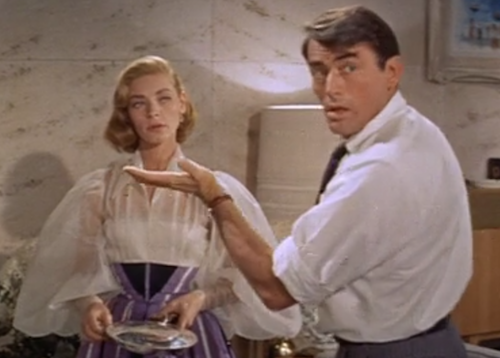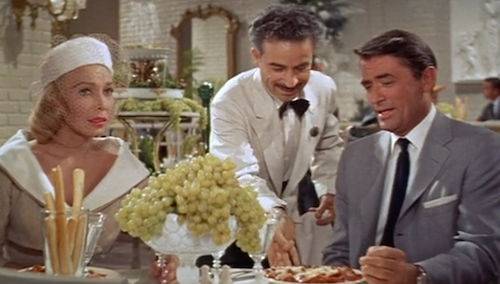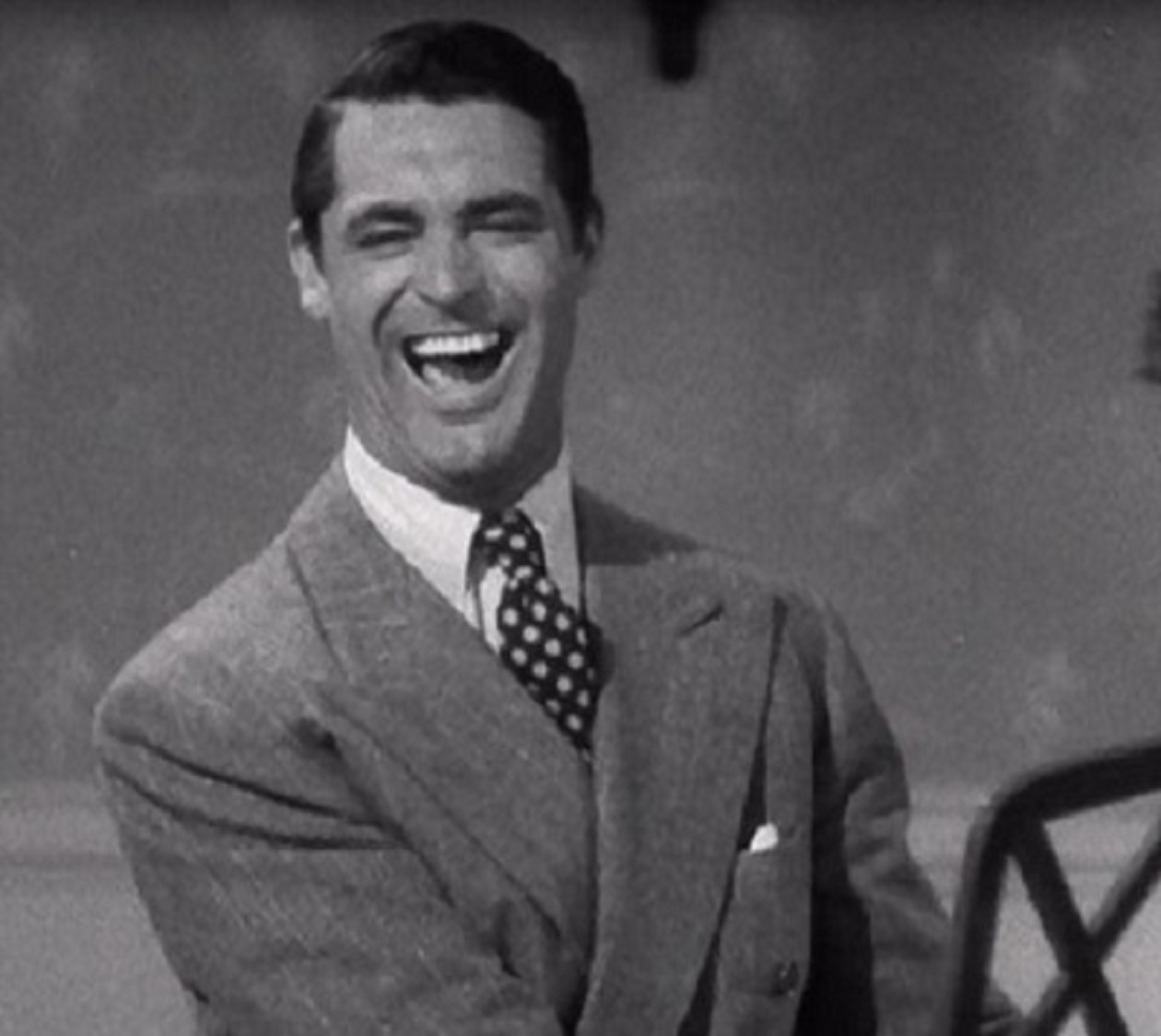
It’s surprising the screenplay for Designing Woman (1957) won George Wells an Oscar, given its strange stew of marital conflict, mob threats, brain damage, fashion, and acrobatic fight moves. But there is a cleverness to it, and some insights about marriage one doesn’t usually get in a comedy. So while not exactly an amazingly tasty stew, it’s curious enough in flavor to keep you watching, and the fourth-wall-breaking format leads to moments of humor throughout, especially through the thoughts of the ex-girlfriend.
Of course, being a fan of complex heroines, I hoped Designing Woman would have a double meaning, that Lauren Bacall’s fashion designer bride had sneaky moves up her perfectly tailored sleeves. Alas, no such luck. Marilla (Bacall) is a sophisticated businesswoman, but traditional when it comes to her sports reporter husband, Mike (Gregory Peck). The two have married after a very short affair, and much of the story hinges around his utterly unnecessary concealment of a former flame, Lori (Dolores Gray), and Marilla’s anxiety about it. The couple is so prickly over this conflict that they endanger Mike’s life as he hides from the mob. (Mike, it seems, is more truthful in reporting than in life, and has ticked off a boxing fixer with mob ties.)
So here are my thoughts on the memorable moments of this Vincente Minnelli-helmed comedy: the flavorful additions, the questionable spices, the discordant ingredient that nearly destroys the whole, and a wonderful final pinch of flavor.
The Flavorful Moments
Confession to the Ex
Mike’s former girlfriend, Lori (Dolores Gray), adds wonderful comedy to the plot, which has gotten a little too sweet in the opening meet-cute aftermath. Mike keeps not getting around to breaking his marriage to her, and she, sharing her reflections with us, reveals, “He was so pathetic I had to help him out.” She generously delivers the breakup news, and then adds a jab he completely misses: “I’d have probably done the same thing myself if I’d found the right man.”
After she relieves him from hurting her feelings, she observes him to be as “grateful as a Saint Bernard.” Her initial euphoria over her own maturity and strength soon dissolves: “But then I made a mistake. I asked him to tell me about her, and he made a bigger mistake, he told me.”

Rolling her eyes, she listens: “I heard all about her eyes, and her hair and her figure….I heard all about her fine sense of humor, and her clothes, and the cute way she had of tilting her head when she laughed….After a while I knew her like a sister.” And of course, she gets a thoroughly justified revenge with a strategic placement of his ravioli plate.
Party Scenes
The movie highlights the divisions between this high-class business leader and her working-class husband in various ways, most successfully with their apartments: his small and messy; hers refined, large, and including what he calls an “outside flunky.” Before he’s had time to look around his new place, all her friends arrive and rush her, barely registering his presence as he tries to excuse the embarrassingly short pants he’s wearing (his own being smeared with ravioli). Even when he leaves the room to change and returns, her distracted friends ignore him. And she is oblivious to his annoyance and embarrassment as she dons and then leaves behind his handsome form. The scene is perfectly orchestrated to reveal his disconnection and loneliness, and the way she’s suddenly made him feel alienated and extraneous in his own home and marriage.
In the aftermath, she’s dismissive of her career to soothe his ego, the embodiment of a bride worried about losing her new man. Luckily, she’s humbled herself enough to ease his insecurity (sigh, at least she doesn’t give up the career). The later party scene, with her rehearsal and his poker game colliding, is so cacophonous it’s actually hard to watch, but perfectly captures just how unalike their work lives are. Both of them are occasionally petty and jealous as they try to navigate in one another’s worlds, and yet come back together through their feelings for one another. The movie never suggests this union will be easy, and there’s something refreshing about that, and–unlike many romantic comedies–very honest.
The Fight Scene
The hilarious antics of the final fight scene make for good comedy. It’s well orchestrated, especially a brilliant final touch (see below). In a favorite moment, Mike observes that his wife doesn’t know how to help, as she can’t identify who is on Mike’s side, and who is not. I loved this reflection, as it echoes my reaction to every bad action sequence I’ve seen in the past decade. I so often can’t tell characters apart once the fists or legs start flying.
The Rotten
I don’t expect PC treatment of subject matter in my 50s films, but usually, I can cringe a bit at unfortunate touches and move on. Unfortunately, much of the comedy of Designing Woman hinges around making fun of a former boxer’s brain damage. Yes, you read that correctly. Maxie (Mickey Shaughnessy) is tasked with protecting Mike from the mob, but can never quite figure out what town he’s in, or what it is he’s supposed to do. Mike is by turns exasperated with him and condescending toward him. Marilla’s not much better, and sometimes worse. Mickey Shaughnessy’s performance is, unfortunately, often convincing, making his character’s brain damage poignant when the actor’s going for funny. The only way to enjoy this comedy is to block out whenever he’s on the screen, which is often.
The Brilliant Final Touch
Early in the film, in a typical bro kind of way, Mike objects to the effeminate dancing style of Marilla’s friend and colleague, musical director Randy (Jack Cole). You can just hear the homophobic chains in Mike’s mind churning as he watches those fluid, flamboyant movements, even before he imitates him to Marilla. But when the mob is beating up Mike and his friends, Randy appears and starts taking out half of them with his dance moves. I haven’t seen dance fighting this fun since Kevin Bacon’s in Footloose.
It’s in this moment of brilliance that you know Minnelli’s at the helm, and you’re so glad. I only wish we’d seen more such flourishes of his style because I could watch that clip over and over again. There, as elsewhere, I was more interested in the musical Marilla was designing for, than the marriage she was trying to save. The problem is, I think Minnelli was too. Luckily, there’s enough of the lovely costumes (and how Bacall wears them), enough of the self-absorption of those running the musical (who find the mob fight merely distracting) to intrigue and entertain. And of course, you can always rewatch Randy….
Hope you’ll enjoy the many other contributions to this Minnelli blogathon hosted by the marvelous Michaela of Love Letters to Old Hollywood.

Yes, this movie is all over the place, but it’s pretty to look at and it makes me laugh. MGM had Dolores Gray and they gave her some nice showcases, but not nearly enough.
She’s wonderful in it, isn’t she? So funny. Love her sarcastic tone. Reminds me of Nora Ephron’s deadpan delivery in her memoir I just listened to–
I love this movie, but you’re right, it has its problems. The stuff with Maxie always makes me uncomfortable; I usually fast-forward or mute those moments. But I adore the scenes with Lori and Randy. When he walks in on Mike mocking him and shows him photos of his wife and kids, I get a big smile on my face. Very well-written post, Leah! So glad you joined the blogathon!
Thanks, Michaela! And thanks for hosting such a great event.
For some reason, I’ve never seen this film in its entirety. And I’m feeling ripped off that I’ve never seen any of Dolores Gray’s scenes. Well, I’m going to remedy that ASAP.
I really enjoyed your review. Love how you structured it. 🙂
Her delivery is fantastic. You really need to see the breakup scene, if nothing else:) Thank you!
I’m surprised to hear just how non-PC the film is with regard to someone with a disability. How far we have come, in some ways at least! It sounds like that would spoil it, but I’d give it a look at least, with Bacall and Peck in the leading roles.
It’s not Bacall’s best performance, or Peck’s, for that matter, but in those moments when she gets to be regal and he gets to be relaxed, they’re fun to watch. Yes, it’s disappointing–and though it’s far less important, those parts are just flat out unfunny.
That’s an interesting comment – about it being less important that it’s less funny. It made me wonder, if it was funny, would we perhaps be willing to forgive the non-PC material, on the basis that it’s from the 1950s. I think we would, probably. I can’t think of another example of portraying a person with disabilities as the butt of jokes in old comedies except perhaps some of Jerry Lewis’s characters? But then, he’s actively participating so maybe the humour empowers the “disabled” character in a way? Anyway, having thought about it, I think the failure of the set up with the “disabled” character in this film, to be funny, is significant because the lack of humour has drawn your attention to what, without any humour, just seems awkward and mean-spirited.
You’re probably right. The lack of humor definitely draws our attention to its mean-spirited nature. I don’t really need humor to be PC if it’s less targeted–or more generous in spirit. When they’re hard on everyone, humorists can get away with it.
Great and honest review! 🙂
I must admit I had completely forgotten this film was directed by Minnelli and I’ve also forgot a bit what happens in it (the details I mean), so I don’t know if it’s a good thing. :/ But I remember enjoying it, luckily! Don’t forget to take a look at my contribution! 🙂
https://thewonderfulworldofcinema.wordpress.com/2016/12/19/the-vincente-minnelli-blogathon-the-pleasures-of-father-of-the-bride-1950/
Thanks, Virginie. Definitely will!! What a fun blogathon it’s been.
I love both Peck and Bacall, and I’d give this film a chance, even though I already know by your review that it’s far from perfect. Great review, by the way.
Don’t forget to read my contribution to the blogathon! 🙂
Kisses!
Le
http://www.criticaretro.blogspot.com
Thank you! I love reading your work and will definitely check it out.